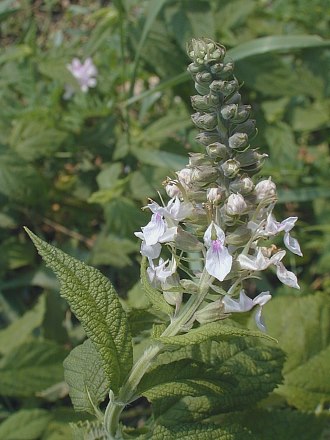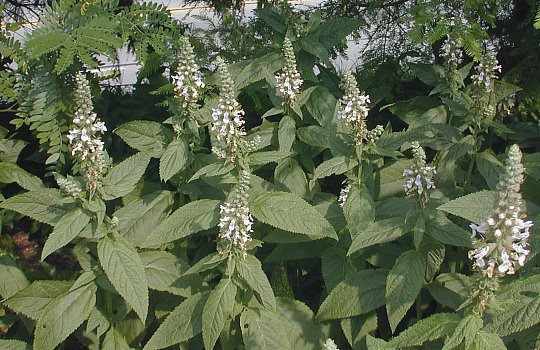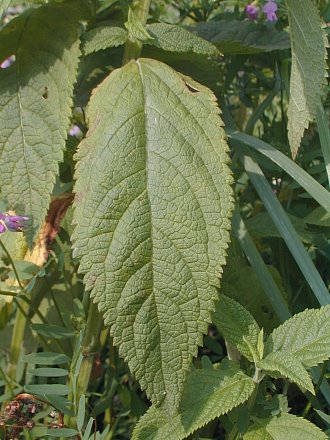Description: This is a perennial plant that is about 2-3' tall. It has a stout central stem with four prominent ridges, while much smaller side stems may appear above the leaf axils in the upper half of the plant. The opposite leaves are up to 5" long and 2½" across. They are broadly ovate or lanceolate, coarsely serrated, and have deep venation. The lower leaves have short stout petioles, while the upper leaves are sessile. At the end of each stem is a terminal spike of numerous small flowers from 1-5" long. The flowers are white or light lavender with some purple near the base of the lower lip. Each flower is about 1/3" (8 mm.) long, with a greatly reduced upper lip and a long lower lip with a complicated structure. This lower lip functions as a landing pad for insect visitors, above which are two pairs of lateral petal-like extensions. The blooming period occurs from mid- to late summer, and lasts about 1½ months. There is no noticeable scent to the flowers. Each flower produces four round, coarsely pitted seeds with scattered white hairs. The root system is fibrous and rhizomatous. This plant spreads readily to form sizeable colonies.

Cultivation:
The preference is full or partial sun, moist conditions, and a fertile
loamy soil. American Germander can tolerate poorly drained conditions,
but not much drought. It is occasionally bothered by foliar disease,
particularly powdery mildew, when the plant is under stress, but not to
the same degree as Wild Bergamot and other susceptible members of the
Mint family. This plant can spread aggressively under moist conditions,
and is rather weedy.
Range & Habitat:
This is a common native plant that occurs in every county of Illinois
(see Distribution
Map). Habitats include moist black soil prairies, edges of
bottomland forests, thickets, moist meadows along rivers,
edges of marshes, and around
seeps. American Germander can also be found in more developed areas,
such as abandoned fields, partially shaded vacant lots, poorly drained
waste areas, and along ditches near roads and railroads.

Faunal
Associations:
Long-tongued bees are the most important pollinators, including
bumblebees, honeybees, Anthophorine bees, Cuckoo bees, Miner bees, and
Leaf-Cutting bees. These bees collect pollen or suck nectar from the
flowers. Other flower-visiting insects include Green Metallic bees, Bee
flies, Thick-Headed flies, and various butterflies or skippers.
Hummingbirds and Hummingbird moths are unusual visitors seeking nectar.
Mammalian herbivores don't bother this plant because of the bitter
leaves.
Photographic Location:
The photographs were taken in a partially shaded waste area near a road
in Urbana, Illinois.

Comments: This native plant is easy to confuse with other members of the Mint family, including the Eurasian species. It can be distinguished from all of them by the complicated structure of the long lower lip versus the greatly reduced size of the upper lip in the flowers. Some plants have a slight pubescence on the calyx and bracts, which are identified as var. boreale, while others lacking this pubescence are identified as var. virginicum. The former variety is absent from the southwestern counties of Illinois, while the latter variety occurs in every county. The unpleasant-tasting leaves were assumed to have medicinal value during pioneer days.